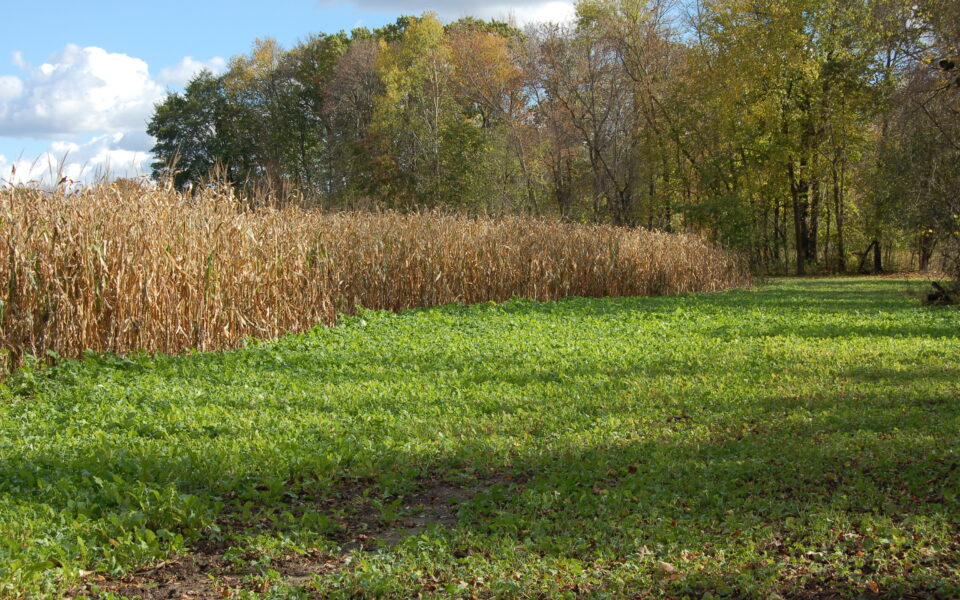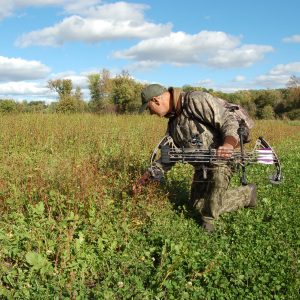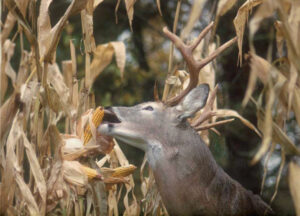
Some believe you must have a corn planter or drill to plant corn. We didn’t. If you understand a few intricacies, broadcasting corn in your food plot can easily be done! Seed rate and ratios, and seed depth are two of the most important factors. You must also have adequate acreage to appease the herd’s feeding intensity.
If I had to pick a favorite between brassicas and corn, brassicas win hands-down. However, on some days they want/need the carbohydrates in corn. Carbohydrates equal “heat.” So if you have enough ground, I suggest you should plant both.
While this particular plot has mainly been used for what most would refer to as a “destination feeding plot,” we did have treestands placed in several spots so it could be hunted. When we had a “bad wind” for somewhere else on the property, you could usually go to “cornholio” and find a safe spot in one of two locations. And let me also be clear, if a big buck is showing up to one of my destination feeding plots during “legal hunting hours,” nuts to the “hunting plot”/“feeding plot” labels.
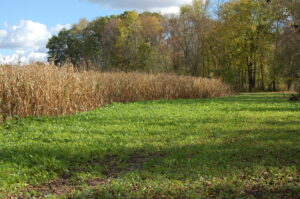
Although it was a large open area (for SW Ontario), you could often create a “close contact” by using scent, calling or decoys, or a combination thereof. Otherwise, chances were you might also observe something at a distance that could provide you with intelligence to make the ambush somewhere else, later.
What about the “density to acreage” issue? Corn is not “a great yielding plant” in comparison to other food plot crops, so you will need enough acreage in corn to keep up with the amount of deer, turkeys, and other animals feeding on it. This “enchanted number” will vary depending upon many factors – your location north to south, quality and amount of native foods, how much total acreage you’re putting into corn, whether or not there is cash-crop corn farming nearby, etc.
A one-acre plot of corn in the northern half of the country or Canada will be ripped out by the roots before it ever has a chance to tassel…if that’s all there is in the area. You’ll just have to estimate and give it a shot. It’s typically the corn plots two acres and larger when I begin to have success. A good place to start would be at least six to eight total acres of corn in spots where corn farming is prevalent, and at least ten to twelve acres in spots where there is no corn farming in the area to back you up. Then adjust as you see required.
OK, you’ve got the acreage, but no corn planter. Corn can be broadcasted. Other larger seeds not commonly planted this way can also be broadcasted. In fact, I’m not aware of any food plot crop that can’t be broadcasted.
Where normally I like to prepare a seedbed well in advance of planting and prefer a firm, weed-less, flat seedbed. When broadcasting larger seeds like corn, beans, or peas I prefer a somewhat fluffier bed. This way the soil covers the seeds easier. I can manipulate the soil easier to cover deeper if it’s just been worked. In fact, when using a Roundup Ready variety of corn, I sometimes won’t initially burn-down the spot first since I’ll be coming back about 30 days later to apply glyphosate anyhow.

With new concerns over the chemical glyphosate, I’m not sure what to believe. In every article I’ve researched it always said, “glyphosate may,” “glyphosate might,” it was never “glyphosate does, did, has or will.” So not knowing much more for certain, I will definitely be more cautious, but I still think it’s the best choice to get the job done – I mean, I’ve always worn eye protection, a breathing safeguard, and covered all my skin, but I’ve probably taken too many chances and this will be on my mind if I use it again.
This; however, has inspired me to learn more about alternative methods of weed control like crimping, crop rotation, using cover crops, and planting methods like the “three sisters” technique written about in the last issue of Gamekeepers, by Scott Raley. Corn can pair well with certain other crops when planted in the correct ratios.
Mr. Raley suggested; 5 lbs. heirloom field corn, 5 lbs. climbing beans, 5 lbs. peas, and 3 lbs. squash. I’m going to test this recipe for myself because his plots looked good.

I’ve had success with mixing corn (usually two or three varieties – one early maturation, one for big production and the other usually drought-tolerant) with several types of annual legumes (usually a couple different varieties of soybeans – one big forage producer, another that will vine up the corn with good pod production, and another with a different characteristic to help level the odds for plot success). Then, plant at a rate of about 10% to 20% corn, with the remainder in the legumes. Different peas or lablab can also pair well with corn.
This year I’m excited to try BioLogic’s Wildlife Sweet Corn with two or three annual legumes and try “Raley’s three sisters’ approach” by adding a squash cultivar or two. While whitetails will eat squash, its main job, in my opinion, is weed-control. I’ve even added pumpkins to this idea and used to grow some beautiful Jack-o-lanterns for my kids, nieces, and nephews for Halloween. The remaining pumpkins the deer kicked in and ate one bite out of each. I had a second great crop of pumpkins from all the seeds that were left behind.
BioLogic’s Wildlife Sweet Corn is a blend of two heirloom varieties that have over a century of proven reliability. These are NOT Roundup Ready varieties, but I hope I won’t need this technology because of the “three sisters technique.” BioLogic’s corn has a sugar content higher than that of new hybrids and is generally consumed earlier in the fall/winter.
The higher protein and nutrient content seems to make these corn varieties preferred over others. The open-pollinated varieties are non-GMO and as mentioned, are not glyphosate-resistant. One variety used in this blend is a fast maturation, dwarf corn and the second variety is a high-yielding sweet corn with a taller stalk and superior heat tolerance.
The key to broadcast planting corn is finding a way to bury the correct amount of seeds at the appropriate depth. Any type of broadcaster will do as long as it will spread the seeds for you. Here’s part of the secret – since not every seed will be buried at a uniform depth like it would be with a drill, from my experience you want to increase your seed rate by approximately 15%. Some seeds will be a little deep and some seeds will be a little shallow, but the better majority will be in an acceptable “germination zone.”
Because of the importance of this detail, finding an implement that will cover the seeds the proper depth (considering your particular soil type and way of preparing the seedbed) is vital. It should only take a small amount of “trial” and then “examining your results.” I’ve had success with certain cultipackers, disks, drags, and harrows. Experiment, while one method might work in sand or sandy/loam soil, it may be completely useless in clay. From my experience, I prefer a harrow-drag in sandy soils and a disk in clay.
You may also broadcast each element of your blend separately – corn separate from beans, and then squash separate from those, etc. Each element can be spread by itself. When you have different sizes, shapes, and weights to the seeds in a particular blend, they can often separate in the hopper, especially in larger containers on vibrating machines.
The error you risk with this “separate seed” method is putting on too much of each seed type. You must remember that because you’re planting additional varieties or species, you don’t need as much of each and ratios must be kept in check for the benefit of the entire stand. Like I always say, “Measure how much you need, set your broadcaster lean with the goal of covering the entire area, and still have some seed left in the hopper. Then, basically cover the plot again, maybe in a different pattern, until the seed is used.”
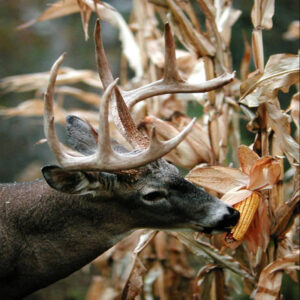
The rule of thumb when using a disk to bury seeds is to set it at twice the depth you want the seeds planted. So if you have a 1-inch planting depth, set the disk at 2 inches, an inch and a half planting depth, set the disk at 3 inches. Again, not every seed will be perfect, but by increasing your seeding rate 15%, the better majority should be. You may have to practice a bit with your method, and fine-tune it as you go, but I broadcast plant corn all the time with success.
You really can’t beat the look or yield of a plot done with the proper equipment, and I do use a corn planter from time to time and a drill for planting beans. However, as an absentee landowner, I don’t have the trailer space to bring a tractor, disk, and other possible implements along with a corn planter every trip – so I’ll continue to use a broadcaster for most everything. I prefer an ATV mounted broadcaster, but a tractor mount, hand-held, or the ol’ over-the-shoulder bag spreader, they will all work.
I’ve tried covering the corn seed with a disk, but my preferred method is to use a harrow – an implement consisting of a heavy frame with tines or teeth. I’ve heard it called a “drag” or a “harrow-drag” also, but they’re typically sold in 4’ by 6’ foot sections. The tines are usually about 8 to 12 inches long and angled one way so it can be used in three different ways – aggressive with the teeth angling forward, medium aggressive with the teeth angle back, or completely flipped over so the teeth aren’t engaged at all (so it can be used for planting smaller seeds like clovers and brassicas, too).
I’ve messed around with recipes over the years and for an easy no fuss, no mess wildlife plot, mixing certain plant- types together can work well. The beans affix good nitrogen so you get beautiful green corn that cobs-out well and the different species aren’t too much competition for one another if they’re planted at correct rates.
If you choose to plant your corn separately, if broadcasting, simply go by the rate in the original instructions for that specific variety, but increase it by about 15% from what they suggest for the normal, drilled rate. Anyone with the simple equipment of a broadcaster, sprayer, harrow-drag, and an ATV, can have a corn plot. The wildlife will prosper, it’s really easy to do…and you can name your plot whatever you’d like.
Join our weekly newsletter or subscribe to GameKeepers Magazine.
Your source for information, equipment, know-how, deals and discounts to help you get the most from every hard-earned moment in the field.

